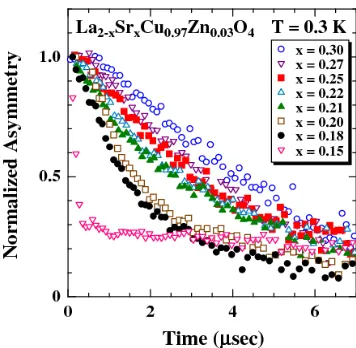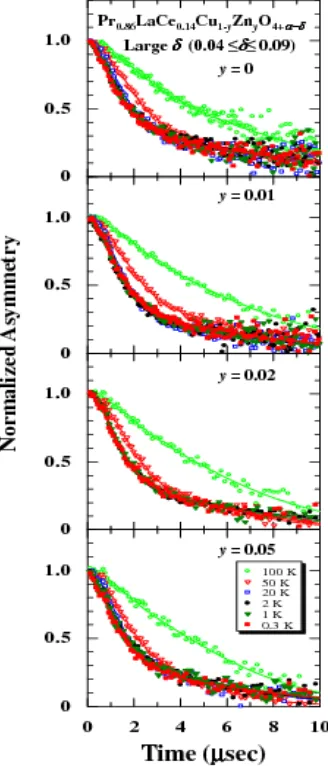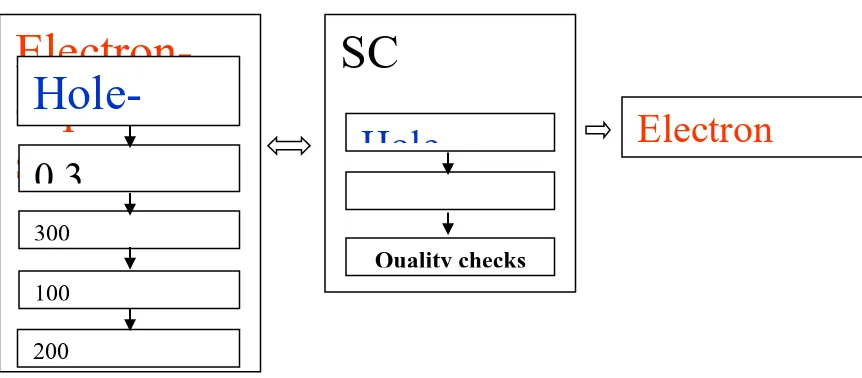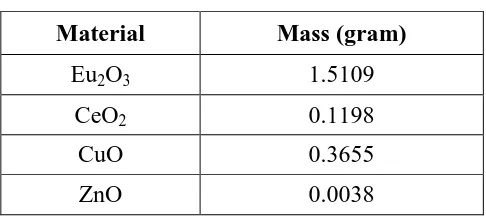LAPORAN KEMAJUAN
KEGIATAN PENELITIAN UNGGULAN PERGURUAN TINGGI PROGRAM HIBAH DESENTRALISASI
TAHUN ANGGARAN 2013
CRYSTAL GROWTH AND SPIN DYNAMICS STUDY OF ELECTRON-DOPED HIGH-Tc SUPERCONDUCTING CUPRATES Eu2-xCexCu1-yZnyO4
Tahun ke 1 dari rencana 1 tahun
Ketua Tim
Dr. Risdiana, S. Si., M. Eng. (NIDN : 0005057501) Anggota Tim
Dr. Togar Saragi, M. Si. (NIDN : 0026086803) Dra. Tuti Aryati Demen, MS. (NIDN : 0004124903)
DIBIAYAI OLEH : DANA DIPA UNPAD No. 023.04.2/189726/2013 Tanggal 5 DESEMBER 2012
LEMBAGA PENELITIAN DAN PENGABDIAN KEPADA MASYARAKAT UNIVERSITAS PADJADJARAN
i
HALAMAENGESAHAN
Judul : Crystal Growth and Spin Dynamics Study of Electron-doped High-Tc Superconducting Cuprates Eu2-xCexCu1-yZnyO4
Peneliti/Pelaksana
Nama Lengkap : Dr. Risdiana, S.Si., M. Eng.
NIDN : 0005057501
Jabatan Fungsional : Lektor Kepala Program Studi : Fisika
Nomor HP : 082117161404
Alamat surel (e-mail) : [email protected] Anggota (1)
Nama Lengkap : Dr.Togar Saragi, M.Si.
NIDN : 0026086803
Perguruan Tinggi : Universitas Padjadjaran Anggota (2)
Nama Lengkap : Dra.Tuti Aryati Demen, MS.
NIDN : 0004124903
Perguruan Tinggi : Universitas Padjadjaran Institusi Mitra
Nama Institusi Mitra : Tohoku University
Alamat : 6-6-05 Aoba, Aramaki, Aoba-ku, Sendai 980-8579, Japan Penanggung Jawab : Prof. Yoji Koike
Tahun Pelaksanaan : Tahun ke 1 dari rencana 1 tahun Biaya Tahun Berjalan : Rp. 167.500.000
Biaya Keseluruhan : Rp. 167.500.000
ii ABSTRACT
The main purpose of this research is to elucidate the hole-electron doping symmetry in the high-Tc cuprates and to find the key phenomena for explaining the appearance of
high-Tc superconductivity. In order to progress this proposed study, the so-called
stripe-pinning model of spins and charges is suggested to be a probable one. It is well known that the stripe correlations tend to be pinned and statically stabilized by nonmagnetic Zn impurities and the Cu-spin fluctuations around Zn exhibit slowing down due to the pinning of the dynamical stripes by Zn, leading to the formation of a static stripe order and the destruction of superconductivity around Zn. This is called a stripe-pinning model. The existences of stripe correlations of spins and charges have been established in hole-doped systems.On the other hand, the stripe correlations have not yet been clearly observed in electron-doped systems even though the high-Tc
superconductivity actually appears. Thus, the dynamic property of the electronic state of electron-doped systems is now recognized to be important to understand the role of stripes to the superconductivity. However, because of difficulties of sample preparations, the study of electron-doped systems has not been progressed so much and clear answer has not been achieved yet. We proposed to growth high quality polycrystalline samples of electron-doped high-Tc superconducting cuprates Eu 2-xCexCu1-yZnyO4. The advantage point of this sample rather than other types of
electron-doped system is that the absence of rare earth moments such as Pr3+ moments in Pr 1-xLaCexCuO4. Using these samples, we can directly observe the behavior of Cu-spins
dynamic and the effects of impurity to the Cu-spins in electron-doped system. Thus, this system would be a good candidate to achieve the answer to our objectives of this proposed study. Until July 2013, we successfully prepared as-grown samples of Eu 2-xCexCu1-yZnyO4 with y = 0.01, 0.02 and 0.05. The next step is trying to reduce oxygen
iii PRAKATA
Puji dan syukur kami panjatkan ke hadirat Allah SWT sehingga laporan kemajuan penelitian dengan skema unggulan perguruan tinggi Universitas Padjadjaran
”international collaboration and scientific publication” dengan judul ” Crystal Growth and Spin Dynamics Study of Electron-doped High-Tc Superconducting Cuprates Eu
2-xCexCu1-yZnyO4” dapat diselesaikan tepat waktu. Dengan mengandalkan jaringan
kerjasama berbasis MoU dengan berbagai instansi di luar negri seperti dengan Graduate School of Engineering Tohoku University, Japan, beberapa karakteristik yang dibutuhkan pada penelitian ini dapat diperoleh dengan baik. Kami masih terus berupaya untuk melengkapi seluruh data yang dibutuhkan sehingga hasil akhir dari penelitian ini dapat bermanfaat untuk institusi yang memberi kami sokongan dana dan juga bagi masyarakat pada umumya.
Kami mengucapkan banyak terimakasih kepada Ketua dan Sekretaris LPPM Unpad beserta jajarannya, Dekan dan para pembantu Dekan Fakultas Matematika dan Ilmu Pengetahuan Alam Universitas Padjadjaran beserta jajarannya, ketua dan sekretaris Jurusan Fisika beserta tenaga kependidikan dilingkungan jurusan fisika dan tak lupa kami juga mengucapkan terimakasih kepada rekan-rekan peneliti di Laboratorium Material Maju untuk Energi Terbarukan (LAMRE) yang telah membantu berbagi beberapa alat sintesis dengan tim kami.
Jatinangor, 22 Juli 2013
iv CONTENT
LEMBAR PENGESAHAN i
ABSTRACT ii
PRAKATA iii
CONTENT iv
LIST OF FIGURE v
LIST OF TABLE vi
CHAVTER I INTRODUCTION 1
CHAVTER II LITERATURE STUDY 3
CHAVTER III OBJECTIVE AND BENEFIT 8
CHAVTER IV RESEARCH METHODOLOGY 9
CHAVTER V RESULTS 11
5.1 Crystal Growth of Electron-Doped Cuprates Eu1.85Ce0.15Cu1-yZnyO4 11
5.2 XRD Characterization of As-grown Eu1.85Ce0.15Cu1-yZnyO4 13
CHAVTER VI RESEARCH PLANNING 15
6.1 Annealing Process 15
6.2 Characterizations 15
CHAVTER VII CONCLUSION 16
v
LIST OF FIGURE
Figure 1. Schematic phase diagram of the hole- and electron-doped 214 cuprate. AF and SC indicate antiferromagnetic order and superconductivity, respectively.
3
Figure 2. ZF-SR time spectra of hole-doped La2-xSrxCu0.97Zn0.03O4 with x =
0.15 - 0.30 at 0.3 K (Risdiana et al., 2008).
5
Figure 3. ZF-SR time spectra of electron-doped Pr0.86LaCe0.14Cu 1-yZnyO4+- with y = 0, 0.01, 0.02, 0.05 and large values (0.04 ≤
≤ 0.09) (Risdiana et al., 2010).
6
Figure 4. Diagram Block for research methodology 9
Figure 5. As-grown samples of Eu1.85Ce0.15Cu1-yZnyO4+with y = 0.01 (a), y
= 0.02 (b) dan y = 0.05 (c).
12
Figure 6. XRD pattern for as-grown samples of Eu1.85Ce0.15Cu1-yZnyO4 with
various Zn concentrations. For reference XRD pattern for T’ -PLCCO samples is also displayed (a).
vi
DAFTAR TABEL
Table1. The value of mass of each raw material to prepared 2 gram of Eu1.85Ce0.15Cu1-yZnyO4 with y = 0.01.
11
Table 2. The value of mass of each raw material to prepared 2 gram of Eu1.85Ce0.15Cu1-yZnyO4 with y = 0.02.
11
Table 3. The value of mass of each raw material to prepared 2 gram of Eu1.85Ce0.15Cu1-yZnyO4 with y = 0.05
1 CHAPTER I INTRODUCTION
Superconductor is a material that has zero electrical resistivity when they are cooled down to sufficiently low temperatures. Most of superconductors are cuprate compounds. One of their characteristics is that conducting planes of CuO2 are included in their crystal
structures and responsible for their electronic properties. When the CuO2 plane loses one
electron because of doping, one mobile hole remains in the CuO2 planes, leading to the
formation of a hole-doped superconducting cuprate. On the other hand, when the CuO2
plane gets an excess electron, superconductivity realizes and forms an electron-doped superconducting cuprates. Superconductor is a promising material for future applications especially for energy saving such as for superconductor cable without any energy loss of electric power transmission and high performance power storage devices. However, the mechanism describing the role of physical properties in superconductor is still far from being understood clearly. The hole-electron doping symmetry in the high-Tc cuprates has
been one of central interests in relation to the mechanism of the high-Tc
superconductivity. Phase diagrams of the hole- and electron-doped systems are very similar to each other, leading to the view of hole-electron doping symmetry. On the other hand, some properties have been found to be different each other, leading to the
2
may be stronger than that of a small amount of Zn impurities. To our knowledge, however, no one has reported the effects of magnetic impurities on the Cu-spin dynamics in the electron-doped cuprates so that clear conclusion of the relation between the dynamical stripe correlations and superconductivity in the electron-doped cuprates and the conclusion for hole-electron symmetry have not yet been obtained.
Here, we proposed to prepare high quality polycrystalline samples of electron-doped high-Tc superconducting cuprate Eu2-xCexCu1-yZnyO4 in which effect of Zn on the Cu-spin
dynamics are probably clarified. The study of Cu-spin dynamics by ZF-SR in electron-doped of Eu2-xCexCu1-yZnyO4 will be the first experiments in the world to clarify the
3 CHAPTER II LITERATURE STUDY
Superconductivity is a phenomenon observed in many kinds of metal and ceramic material that have zero electrical resistivity when they are cooled down to sufficiently low temperatures. The specimen showing this phenomenon is called a superconductor and the temperature at which the electrical resistivity starts to be zero is called the critical temperature (Tc). Superconductivity was discovered for the first time by H. K. Onnes in
1911.
The era of high-Tc superconductivity began when Bednorz and Muller reported
possible superconductivity in single-layer cuprates called 214 cuprates (Bednorz et al., 1986). The parent compound of these cuprates is La2CuO4. Superconductivity appears by
randomly substituting some Sr atoms for La and forming La2-xSrxCuO4. When a La3+ ion
is replaced by Sr2+, the CuO2 plane loses one electron so that one mobile hole remains in
the CuO2 planes, leading to the formation of a hole-doped cuprate. Another family of
single-layer cuprates is the electron-doped (Nd, Pr, Sm)-Ce-Cu-O. In these materials, when a Nd3+ or Pr3+ or Sm3+ is replaced by Ce4+, the CuO2 plane gets an excess electron,
leading to the formation of an electron-doped cuprates (Tokura et al., 1989). All of the crystals have common structures consist of both the conduction layer (CuO2 plane) and
the charge reservoir layer. CuO2 planes are responsible for their electronic properties.
4
Figure 1. Schematic phase diagram of the hole- and electron-doped 214 cuprate. AF and SC indicate antiferromagnetic order and superconductivity, respectively.
The so-called hole-electron doping symmetry in the high-Tc cuprates has been one of
central interests in relation to the mechanism of the high-Tc superconductivity. Phase
diagrams of the hole- and electron-doped systems are very similar to each other. That is, the parent compounds are both Mott insulators exhibiting long-range antiferromagnetic order with similar values of the Neel temperature. The superconducting phases appear through doping holes or electrons into the Mott insulators as shown in Fig 1. These properties lead to the view of hole-electron doping symmetry. On the other hand, some properties in the electron-doped superconductors have been found to be different from those in the hole-doped superconductors, leading to the hole-electron doping asymmetry. First, the effectiveness of carriers for destroying the long-range antiferromagnetic order is different between the hole- and electron-doped systems. In the electron-doped system of Nd2-xCexCuO4, the long-range antiferromagnetic order survives up to x ~ 0.13 (Takagi et al., 1989), while it survives only up to x ~ 0.02 in the hole-doped system of La2-xSrxCuO4.
Secondly, in the inelastic neutron-scattering measurements, an incommensurate spin-correlation, which may be due to the so-called dynamically fluctuating stripes of spins and holes (Tranquada et al., 1995), has been found in the hole-doped system (Yamada et al., 1998). In the electron-doped system, on the other hand, a commensurate spin-correlation, which is related to the simple antiferromagnetic order, has been observed (Yamada et al., 2003).
As for impurity effects, different behaviors between the hole- and electron-doped systems are also observed. For examples, the superconductivity in the electron-doped system is suppressed through the substitution of magnetic Ni for Cu more markedly than through the substitution of nonmagnetic Zn for Cu (Tarascon et al., 1990), which is contrary to the result in the hole-doped system (Xiao et al., 1990).
From the view of the Cu-spin dynamics properties, one of important phenomena in the 214 cuprates is that in hole-doped system, charge in the CuO2 plane are not distributed
5
manifestation of a self-organized state. In 1995, Tranquada et al. suggested a stripe model of spins and holes from neutron scattering measurements to understand the mechanism of the 1/8 anomaly around p = 1/8 (Tranquada et al., 1995). That is, dynamically fluctuating stripes are pinned and stabilized by the tetragonal low-temperature structure (space group: P42/ncm), leading to the static stabilization and suppression of superconductivity
at p = 1/8. These results can be well described using the stripe model. This model consists of hole (charge) domains and spin domains. Charge stripes refer to a charge density wave (CDW) and spin stripes refer to a spin density wave (SDW). From ZF-SR measurements, it has been found that a slight amount of Zn tends to induce slowing down of the Cu-spin fluctuations in the whole superconducting regime of hole-doped system, which is able to be interpreted as being due to pinning and stabilization of the dynamically fluctuating stripes of spins and holes (Risdiana et al., 2008, Adachi et al., 2008).
Figure 2. ZF-SR time spectra of hole-doped La2-xSrxCu0.97Zn0.03O4 with x = 0.15 - 0.30
at 0.3 K (Risdiana et al., 2008).
Figure 2 shows the ZF-SR time spectra at 0.3 K for La2-xSrxCu0.97Zn0.03O4 with x =
6
Therefore, these results suggest that the pinning of the dynamically fluctuating stripes occurs in the overdoped regime as well, that is, the stripe-pinning model holds good even for overdoped La2-xSrxCuO4. This result might point to the importance of the dynamical
stripe correlations in the appearance of high-Tc superconductivity in the hole-doped
system (Emery et al., 1999). In other hand, the mechanism of superconductivity in the electron-doped high-Tc cuprates has not yet been clarified also. It is of great interest
whether the stripe-pinning model holds good even for the electron-doped system or not and whether the mechanism in the electron-doped high- Tc cuprates is different from that
in the hole-doped ones or not.
Figure 3. ZF-SR time spectra of electron-doped Pr0.86LaCe0.14Cu1-yZnyO4+- with y = 0,
7
Figure 3 shows the ZF-SR time spectra of Pr0.86LaCe0.14Cu1-yZnyO4+- with y = 0,
0.01, 0.02, 0.05 and large values (Risdiana et a l., 2010). It is found that the spectra are independent of the Zn concentration, meaning that no impurity-induced slowing down of the Cu-spin fluctuations is detected in electron-doped Pr0.86LaCe0.14CuO4+-. That is, Zn
impurities do not appear to affect the Cu-spin dynamics, which is very different from the results of hole-doped La2-xSrxCu1-yZnyO4 as shown in Fig. 2. This may be understood in
two ways. First, there may be no dynamically fluctuating stripes of spins and electrons in the electron-doped cuprates, because the dynamical stripes lead to the impurity-induced magnetic order in the hole-doped cuprates (Adachi et al., 2004). Second, the effect of Pr3+ moments may be too strong for the effect of a small amount of Zn impurities to be observed. To be conclusive, another electron-doped cuprate without Pr3+ moments such as Eu2-xCexCu1-yZnyO4 should be used for this study. Therefore, the study of spin
8
appearance of high-Tc superconductivity. In order to progress this research, we proposed
to growth high quality polycrystalline samples of electron-doped high-Tc
superconducting cuprates Eu2-xCexCu1-yZnyO4. With these samples, the effects of Zn on
the Cu-spin dynamics are investigated to clarify whether or not the dynamical stripe correlations of spins and charges are observed in electron-doped system as observed in the hole-doped system. The advantage point of this sample rather than other types of electron-doped system is that the absence of rare earth moments such as Pr3+ moments in Pr1-xLaCexCuO4. Using these samples, we can directly observe the behavior of Cu-spins
dynamic and the effects of impurity to them.
3.2 Benefit
The study of Cu-spin dynamics by ZF-SR in electron-doped of Eu2-xCexCu1-yZnyO4
will be the first experiments in the world to clarify the Cu-spin dynamics of electron-doped cuprates. If the stabilization of the Cu-spin fluctuations by Zn is observed in the proposed system, it would be a good sign that the stripe-pinning model can globally explain the high-Tc superconductivity as in the case of hole-doped systems. On the other
hand, in case that any stabilization cannot be confirmed, that would be a good indication that the stripe-pinning model is restricted to describe the superconductivity in the hole-doped systems and that the high-Tc superconductivity in the electron-doped systems is
9
CHAPTER IV
RESEARCH METHODOLOGY
The method of our research is experimental research described in the following figure
Figure 4. Diagram Block for research methodology
Figure 2 shows the research methodology of our proposal. First part is samples preparations. Polycrystalline samples of Eu2-xCexCu1-yZnyO4 with y = 0, 0.005, 0.01, 0.02
and 0.05 were prepared by the ordinary solid-state reaction method as follows [15]. Raw materials of Eu2O3, CeO2, CuO and ZnO powders were mixed in a stoichiometric ratio
and prefired in air at 900oC for 20 h. The prefired materials are reground and pressed into pellets of 10 mm in diameter, and sintered in air at 1100oC for 16 h with repeated regrinding. As-grown samples of Eu2-xCexCu1-yZnyO4, are annealed in flowing Ar gas of
10
previous study in electron-doped Pr1-xLaCexCu1-yZnyO4 and hole-doped La2-xSrxCu
1-yZnyO4 to find the key phenomena for explaining the appearance of high-Tc
11 CHAPTER V
RESULTS
5.1 Crystal Growth of Electron-Doped Cuprates Eu1.85Ce0.15Cu1-yZnyO4
Polycrystalline samples of the electron-doped Eu1.85Ce0.15Cu1-yZnyO4+-
(ECCZO) with y = 0, 0.01, 0.02, and 0.05 were prepared by the ordinary solid-state reaction method. Raw materials of dried Eu2O3, CeO2, CuO and ZnO powders were
mixed in a stoichiometric ratio. Simple calculations and PowderWin program are applied to get accurate mass needed for all samples. For examples, for preparing 2 gram of Eu1.85Ce0.15Cu1-yZnyO4 with y = 0.01, we need to calculate based on the chemical reaction
below:
10.925Eu2O3 + 0.15CeO2 + 0.99CuO + 0.01ZnO → Eu1.85Ce0.15Cu0.99 Zn0.01 + 17.0375O2
After calculating the atomic mass relative (Ar) and molecule mass relative (Mr), we can
get the mass for each raw material listed in Table 1.
Table1. The value of mass of each raw material to prepared 2 gram of Eu1.85Ce0.15Cu
1-yZnyO4 with y = 0.01.
With similar way, the values of mass needed to prepare 2 gram2 gram of Eu1.85Ce0.15Cu
1-yZnyO4 with y = 0.02 and y = 0.05 are listed in Table 2 and Table 3.
Table 2. The value of mass of each raw material to prepared 2 gram of Eu1.85Ce0.15Cu
12
Table 3. The value of mass of each raw material to prepared 2 gram of Eu1.85Ce0.15Cu 1-yZnyO4 with y = 0.05
Material Mass (gram)
Eu2O3 1.5106
CeO2 0.1198
CuO 0.3507
ZnO 0.0189
After mixing all raw materials, the samples are prefired in air at 900oC for 20 h. The prefired materials were reground and pressed into pellets of 10 mm in diameter, and sintered in air at 1100oC for 16 h with repeated regrinding. As-grown samples of Eu1.85Ce0.15Cu1-yZnyO4+are shown in Figure 5.
Figure 5. As-grown samples of Eu1.85Ce0.15Cu1-yZnyO4+with y = 0.01 (a), y = 0.02 (b)
13
5.2 XRD Characterization of As-grown Eu1.85Ce0.15Cu1-yZnyO4
All of the as-grown samples were checked by the powder x-ray diffraction measurements as shown in Figure 6.
Figure 6. XRD pattern for as-grown samples of Eu1.85Ce0.15Cu1-yZnyO4 with various Zn
concentrations. For reference XRD pattern for T’-PLCCO samples is also displayed (a).
Figure 6 shows XRD pattern for as-grown samples of Eu1.85Ce0.15Cu1-yZnyO4 with
various Zn concentrations. They are Eu1.85Ce0.15Cu1O4 (b), Eu1.85Ce0.15Cu0.99Zn0.01O4 (c),
Eu1.85Ce0.15Cu0.98Zn0.02O4 (d) and Eu1.85Ce0.15Cu0.95Zn0.05O4 (e). For reference XRD
14
All the peaks show clear single phase peak without any impurities. These results indicated that we succeeded in preparing as-grown samples of electron-doped superconducting cuprates Eu1.85Ce0.15Cu1-yZnyO4.
15 CHAPTER VI RESEARCH PLANNING
6.1 Annealing Process
After getting as-grown samples, the next step is trying to reduce oxygen content by annealing in Argon gas flow. The temperatures needed in this process are in the range of 900 oC to 950oC for 10 to 24 hours. The reduced oxygen can be estimated by weight changed before and after annealing.
Annealing process will be doing in Laboratory of Advanced Material for Renewable Energy, Department of Physics, Faculty of Mathematics and Natural Sciences,
Padjadjaran University.
6.2 Characterizations
Next part of this research is checking quality and measuring transport properties of the samples. Crystal structure will be checked by XRD. Electrical resistivity and DC
magnetic-susceptibility measurements will carry out at low temperatures down to 2 K using a standard SQUID magnetometer (Quantum Design, Model MPMS-XL5) in a magnetic field of 10 Oe on field cooling. All this part will be doing in Koike Laboratory at Tohoku University. The last part is measuring spin dynamics properties by SR. The ZF- and LF-SR measurements were performed at low temperatures down to 10 K at the RIKEN-RAL Muon Facility at the Rutherford-Appleton Laboratory in the UK using a pulsed positive surface muon beam.
16 CHAPTER VII CONCLUSION
We proposed to growth high quality polycrystalline samples and study the magnetic properties of electron-doped high-Tc superconducting cuprates Eu1.85Ce0.15Cu1-yZnyO4
with y = 0, 0.01, 0.02 and 0.05. From XRD pattern, it is found that all the peaks show clear single phase peak without any impurities. These results indicated that we succeeded in preparing as-grown samples of electron-doped superconducting cuprates Eu1.85Ce0.15Cu1-yZnyO4.
The next step is trying to reduce oxygen content by annealing in Argon gas flow, following by checking quality and measuring transport properties of the samples. Crystal structure will be checked by XRD. Electrical resistivity and DC magnetic-susceptibility measurements will carry out at low temperatures down to 2 K using a standard SQUID magnetometer. The last part is measuring spin dynamics properties by SR. The ZF- and
17
susceptibility study”, Phys. Rev. B 78, 134515.
(Adachi et al.,2004) T. Adachi, S. Yairi, K. Takahashi, Y. Koike, I. Watanabe, K. Nagamine, 2004, “Muon spin relaxation and magnetic susceptibility studies of the effects of nonmagnetic impurities on the Cu spin dynamics and superconductivity in La2-xSrxCu1-yZnyO4 with x = 0.115”, Phys. Rev. B 69,
184507.
(Bednorz et al., 1986) J. G. Bednorz and K. A. Muller, 1986, “Possible highTc
superconductivity in the Ba−La−Cu−O system”, Phys. B 64, 189.
(Emery et.al., 1999) V. J. Emery, S. A. Kivelson, J. M. Tranquada, 1999, “Stripe phases in high-temperature superconductors”, Proc. Natl. Acad. Sci. 96, 8814.
(Koike et al., 1992) Y. Koike, A. Kakimoto, M. Mochida, H. Sato, T. Noji, M.
18
Hull, R. Ramesh, 1990, “Magnetic versus nonmagnetic ion substitution effects on Tc in the La-Sr-Cu-O and
Nd-Ce-Cu-O systems”, Phys. Rev. B 42, 218.
(Tokura et al., 1989) Y. Tokura, H. Takagi, S. Uchida, 1989, “A superconducting copper oxide compound with electrons as the charge carriers”, Nature 337, 345.
(Tranquada et al., 1995) J. M. Tranquada, B. J. Sternlieb, J. D. Axe, Y. Nakamura, S.
Uchida, 1995, “Evidence for stripe correlations of spins and holes in copper oxide superconductors”, Nature 375, 561. (Xiao et al., 1990) G. Xiao, M. Z. Cieplak, J. Q. Xiao, C. L. Chien, 1990,
“Magnetic pair-breaking effects: Moment formation and critical doping level in superconducting La1.85Sr0.15Cu1-xAxO4
systems (A=Fe,Co,Ni,Zn,Ga,Al)”, Phys. Rev. B 42, 8752. (Yamada et al., 2003) K. Yamada, K. Kurahashi, T. Uefuji, M. Fujita, S. Park, S.
H. Lee, Y. Endoh, 2003, “Commensurate Spin Dynamics in the Superconducting State of an Electron-Doped Cuprate Superconductor”, Phys. Rev. Lett 90, 137004.





